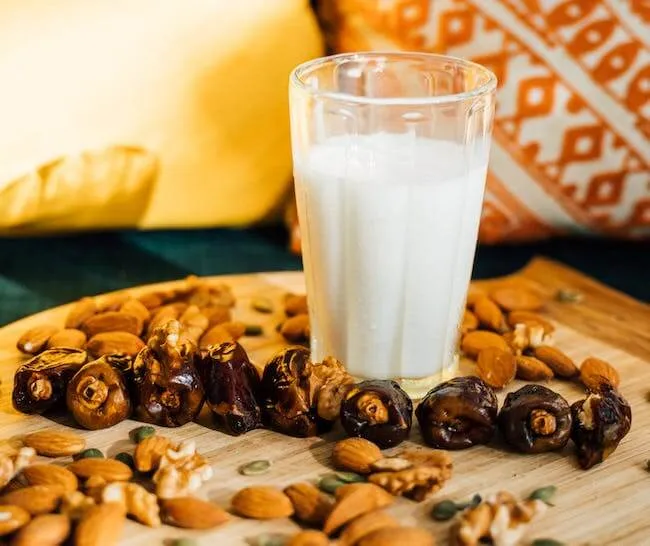Cow’s milk is a good source of many nutrients, particularly “shortfall” nutrients like potassium, calcium, and vitamin D.1
Shortfall nutrients are typically low enough in the diets of children and adults to be of national concern. Milk drinkers get 16% higher potassium, 49% higher calcium, and 180% more vitamin D than those not drinking milk.1
The carbohydrate content of milk causes people to doubt whether it’s beneficial for people living with diabetes to drink milk. Individuals with diabetes need to monitor how much carbohydrates they consume.2
In this article, you’ll learn about the impact of milk on type 2 diabetes, how to include milk in your diet, and the best milk options for people with type 2 diabetes.
{{mid-cta}}
Can People with Diabetes Drink Milk?
People with type 2 or type 1 diabetes can drink milk even though it contains carbohydrates in the form of lactose.2,3,4 If you happen to be in two-thirds of the world’s lactose intolerant population, consuming cow’s milk is not a good option with or without diabetes.5
If you can tolerate lactose, consuming milk as part of a balanced diet can benefit people with diabetes. Monitoring overall carbohydrate intake is essential, no matter the food or beverage source.2
The carbohydrates should be paired with other nutrients such as protein, fiber, and fat to keep blood sugar levels within a target range. Controlling blood sugar levels is critical for managing diabetes and preventing complications.2
Milk contains carbohydrates, essential vitamins, minerals, protein, and fat that help the body digest carbohydrates without blood sugar spikes. Its unique nutrient composition makes it a good option for people with diabetes.
Nutritional Values of Milk
All types of cow’s milk (whole, reduced-fat, and skim) contain the same amount of protein, carbohydrates, and similar levels of calcium, potassium, vitamins A and D.6,7,8
The glycemic index of all types of cow’s milk is low, which is digested and absorbed slowly, leading to fewer blood sugar spikes.
The primary difference is the fat content. Whole milk contains the most fat, then reduced-fat milk, and finally skim milk with no fat.6,7,8
Whole Milk
One cup (8 ounces) of whole milk provides6:
- 149 calories
- 8 grams of fat (4.5 grams of saturated fat)
- 8 grams of protein
- 12 grams of carbohydrate (no added sugar)
- 0 grams of fiber
- 20% of daily calcium needs
- 6% of daily potassium needs
- 10% of daily vitamin A needs
- 20% of daily vitamin D needs
- Glycemic Index low: 39 (digested and absorbed slowly)4
Reduced-fat Milk (2%)
One cup (8 ounces) of 2% milk provides7:
- 120 calories
- 5 grams of fat (3 grams of saturated fat)
- 8 grams of protein
- 12 grams of carbohydrate (no added sugar)
- 0 grams of fiber
- 25% of daily calcium needs
- 8% of daily potassium needs
- 30% of daily vitamin A needs
- 15% of daily vitamin D needs
- Glycemic Index low: 37-39 (digested and absorbed slowly)4
Skim Milk
One cup (8 ounces) of 2% milk provides8:
- 80 calories
- 0 grams of fat (0 grams of saturated fat)
- 8 grams of protein
- 12 grams of carbohydrate (no added sugar)
- 0 grams of fiber
- 25% of daily calcium needs
- 8% of daily potassium needs
- 30% of daily vitamin A needs
- 10% of daily vitamin D needs
- Glycemic Index low: 39 (digested and absorbed slowly)4
What Kind of Milk Can People with Diabetes Drink?

People living with diabetes can drink many types of milk, including cow’s milk or non-dairy milks like unsweetened almond milk or soy milk. Many factors, including lifestyle, flavor preferences, diet, and health conditions, determine which milk best suits a person.
The key factor is ensuring that the carbohydrate content fits within the daily recommended amount for the person's specific eating plan for diabetes.
The American Diabetes Association (ADA) reports that most people living with diabetes consume about 44 to 46% of total calories from carbohydrates. The ADA does not recommend specific carbohydrate numbers but recommends you work with a registered dietitian to determine a customized eating plan.9
Using the typical amount consumed as an example, we will calculate the number of carbohydrates a person consuming 2,000 calories daily would eat.
If 45% of the calories come from carbohydrates, that equates to 900 calories or about 225 g of carbohydrates per day. Divided among three meals and one to two snacks, that would come out to 45-55 grams of carbohydrates per meal and about 25-30 grams per snack.
The nutritional values above show that milk contains 12 grams of carbohydrates per cup. Milk can fit into a diabetes meal plan, taking into consideration other carbohydrate sources from other foods.
Unsweetened almond milk contains 1 gram of carbohydrates in each cup, making it a good option for those wanting to limit their carbohydrate intake amount from milk.10
Sweetened almond milk contains 11 grams of carbohydrates in each cup, similar to cow’s milk, but different in that the carbohydrates come primarily from added sugar.11
Each cup of oat milk contains 16 grams of carbohydrates.12 The carbohydrates in non-dairy milks vary. Checking the food label will help you determine which milk fits into your eating goals.
Type 2 Diabetes and Milk
Most studies associate dairy intake with reduced type 2 diabetes incidence.13
A systematic review in Advanced Nutrition from 2019 included over 500,000 participants aged 20 to 88 years, looking for relationships between dairy consumption and type 2 diabetes occurrence over four to thirty years.13
After an analysis, it was found that the following types of dairy were associated with a lower incidence of type 2 diabetes: total dairy intake, low-fat dairy products, low-fat milk, and yogurt. Specifically, yogurt and low-fat dairy consumption were associated with a lower risk of type 2 diabetes.13
Yogurt reduced the risk of type 2 diabetes by 20%, low-fat dairy reduced risk by 19%, and low-fat milk reduced risk by 18%. Cheese reduced risk by a smaller amount at 9%.13
Evidence for high-fat dairy and reduced risk of type 2 diabetes is limited. The authors encouraged further research to allow for more definitive recommendations regarding high-fat dairy intake.13
Diabetes and Dairy: How to Include Milk in Your Diet

- Choose low-fat dairy foods like low-fat cheese, yogurt, Greek yogurt, and skim milk. Add these to meals and snacks to boost protein and vitamin intake.
- Use low-fat milk in smoothies and fiber-rich fruits and vegetables with a heart-healthy fat source like ground flaxseed for a meal that helps stabilize blood sugar levels and keeps you full longer.
- Try including one to three servings of dairy daily, a good source of protein, calcium, and vitamin D. You can add low-fat milk to breakfast, a slice of cheese to lunch, and yogurt to an afternoon snack.
- Add the carbohydrate amount from milk to your other sources to ensure you eat appropriate carbohydrates. Other carbohydrate sources include bread, pasta, beans, starchy vegetables like corn, potatoes, peas, fruit, sugary foods, and beverages.
Bottom Line
Milk and other dairy products can be a healthful addition to your diet. They boost protein and other shortfall vitamins you may lack, like calcium, vitamin D, and potassium. Low-fat dairy products, such as yogurt, are associated with a decreased risk of developing type 2 diabetes.
Observing how the intake of carbohydrates from milk and other dairy products affects your body and managing type 2 diabetes is essential. Tracking your blood glucose levels and building life-long healthy habits will help you manage your type 2 diabetes well. If you have specific nutrition concerns about including milk or non-dairy milk options in your diet, consult a healthcare provider or registered dietitian.
Using a CGM with Signos: Real-Time Data, Backed by AI
Signos pairs a real-time glucose biosensor with AI trained on tens of millions of data points to deliver personalized, science-backed guidance for weight management and health. See exactly how your body responds, and take action.
Learn how it works. Ready to get started? Join now.
Topics discussed in this article:
References
- Sebastian, R.S., Goldman, J.D., Wilkinson Enns, C., LaComb, R.P. Fluid milk consumption in the United States: What we eat in America, NHANES 2005-2006. Food Surveys Research Group Dietary Data Brief No. 3. September 2010. Available from: http://ars.usda.gov/Services/docs.htm?docid=19476
- The Nutrition Source. (n.d.). Carbohydrates and blood sugar. https://www.hsph.harvard.edu/nutritionsource/carbohydrates/carbohydrates-and-blood-sugar/
- Alvarez-Bueno, C., Cavero-Redondo, I., Martinez-Vizcaino, V., Sotos-Prieto, M., Ruiz, J. R., & Gil, A. (2019). Effects of Milk and Dairy Product Consumption on Type 2 Diabetes: Overview of Systematic Reviews and Meta-Analyses. Advances in nutrition (Bethesda, Md.), 10(suppl_2), S154–S163. https://doi.org/10.1093/advances/nmy107
- Shkembi, B., & Huppertz, T. (2023). Glycemic Responses of Milk and Plant-Based Drinks: Food Matrix Effects. Foods (Basel, Switzerland), 12(3), 453. https://doi.org/10.3390/foods12030453
- National Institute of Diabetes and Digestive and Kidney Diseases. (2018, February). Definition & facts for lactose intolerance. https://www.niddk.nih.gov/health-information/digestive-diseases/lactose-intolerance/definition-facts#:~:text=While%20most%20infants%20can%20digest,world's%20population%20has%20lactose%20malabsorption.
- U.S. Department of Agriculture. (2023, February 16). Whole milk. https://fdc.nal.usda.gov/fdc-app.html#/food-details/2462154/nutrients
- U.S. Department of Agriculture. (2022, December 22). 2% milk. https://fdc.nal.usda.gov/fdc-app.html#/food-details/2405929/nutrients
- U.S. Department of Agriculture. (2023, January 26). Skim milk. https://fdc.nal.usda.gov/fdc-app.html#/food-details/2448227/nutrients
- American Diabetes Association. (2019). Lifestyle management: Standards of medical care in diabetes-2019. Diabetes care, 42(supplement 1), S46-S60. https://doi.org/10.2337/dc19-S005
- U.S. Department of Agriculture. (2023, February 16). Unsweetened almond milk, unsweetened. https://fdc.nal.usda.gov/fdc-app.html#/food-details/2479376/nutrients
- U.S. Department of Agriculture. (2022, October 28). Almond milk, sweetened. https://fdc.nal.usda.gov/fdc-app.html#/food-details/2340789/nutrients
- U.S. Department of Agriculture. (2019, December 6). The original oat-milk. https://fdc.nal.usda.gov/fdc-app.html#/food-details/719016/nutrients




.svg)








.jpeg)

.svg)
.svg)
.svg)
.svg)
.svg)
.svg)
.svg)
